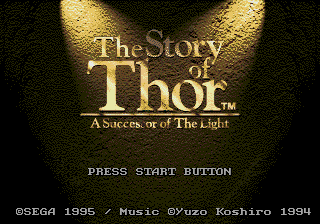Reviewing… Story of Thor (Sega Mega Drive)

I actually meant to get started on these reviews a while ago… better late than never!
My copy of Story of Thor and I go way back to 1994, when I was lucky enough to be given it for Christmas. I’d read the reviews from Sega-stalwart Sega Megazone and was just starting to get into anime (this interest would be fully realised as Robotech replayed over the summer holidays on Agro’s Cartoon Connection and when I saw 3×3 Eyes Part 2 at a friend’s place a few months later), so it seemed like a good combination. Ancient, and by extension Yuzo Koshiro (who rocked my gaming world with Streets of Rage 2 the year previous), helmed the game’s design and it gave me a chance to play a Zelda-like adventure game without having to swallow my pride and invest in a SNES (this would come 18 months later, but that’s another story). These are all very important points to a 12 year old boy you understand, so it’s important to irrationally preface this review accordingly.
I adored the game back in the day – it was an amazing feat for the humble Mega Drive and a fun game in its own right. When I went back to play it recently (“recently” being last year or the year before), I was still confident that the game would hold up well. Turns out I was right.
Visually I still think it’s fantastic – the Mega Drive’s colour palette is used sensibly (as it needs to be – only 64 of those colours can be on-screen simultaneously [or 183 in shadow/highlight mode – thanks Wikipedia]), sprites are large and well-animated (despite later enemies simply being palette-swaps) and there’s plenty of variety in the scenery. As a bonus, the game features a little sprite scaling when you fall down holes or gaping chasms. It’s all typical of Japanese game aesthetics of the era – clean, well-defined and charming with great attention to detail.
The fanboy wants to decry it the audio as an example of technical mastery for the system, and to a degree it is. The problem is that it hasn’t necessarily aged too well – Koshiro’s deft use of the Mega Drive’s audio chipset for the music is actually very good – it’s the garbled sampled audio that lets it down. Back when I was playing this on an old 51cm TV in my bedroom (complete with RF input and 80s faux-wood panelling contact over the MDF), I actually used to run the Mega Drive through my mini HiFi stereo and remember being impressed by the use of the stereo channels to simulate a surround-sound effect with the waterfalls in the palace. The effect’s still prolific, but the sample noise is a little rough on ears now. It was certainly ambitious, and was by no means unpleasant; today, it’s just a bit rough.
Another peculiarity is with the cartridge’s hardware itself and how it interacts with the Mega Drive. I normally run my Mega Drive games in 60hz, but the PAL Story of Thor cart is a bit of an anomaly with the way it handles the different refresh rates. When booted in 60hz it gives the usual region protection error, which isn’t uncommon – why it’s interesting is that when you try the usual trick to get around it (boot in 50hz, then swap to 60hz), the game slows to a halt and the image rolls. The only other games where I’ve seen the same thing happen are Streets of Rage 1 and 2, both of which also happen to be games by Ancient and involve Yuzo Koshiro. My only theory is that Koshiro is using either some unique hardware in the cart (I haven’t popped the cart open to have a look), or the oscillator that provides the refresh rate is tied to the way the game handles video timing, the Z80 audio CPU or other programmable variables. On the upside though, the PAL version of the game is surprisingly well-optimised for PAL TVs, including stretching the image so that it virtually covers the entire screen. I didn’t take notice of this back in the day (it wasn’t until the Saturn era that I became aware of PAL optimisation of games and the joys of 60hz), but it’s a nice touch looking back at it now.
It didn’t take me too long to plough through the game – my memory was surprisingly good and the game really isn’t too tough. There’s no excess padding with enough optional treasure hunting to get the balance just right (though I still didn’t manage to find all the hidden gems this time around!). I think it took up maybe… 5 or 6 hours? That’s a good time frame for me these days, as I’m time-poor given the realities of life typical of someone my age. Playing through games that last over 60 hours is a long slog when I only have a couple of hours each week (if that) to get in some gaming, so it meant Story of Thor was the perfect length to knock out in a couple of weekends.
I won’t assign a score for this one (or any other reviews for that matter), as I don’t think it’s necessary. What’s more important is the experience, and this one still delivers. The great news is that if you missed it back in the day, it’s available via the Wii’s Virtual Console for a cheap download, and M2’s work on the emulation on the Wii is amazing. It’s also on the Sega Mega Drive Collection (or Sonic’s Ultimate Genesis Collection for those in North America) on the PS3 and XB360, but the emulation isn’t anywhere near as precise as M2’s. Still, if that’s all you have access to, it’s worth a go. You even get a trophy/achievement for completing the first dungeon 🙂



